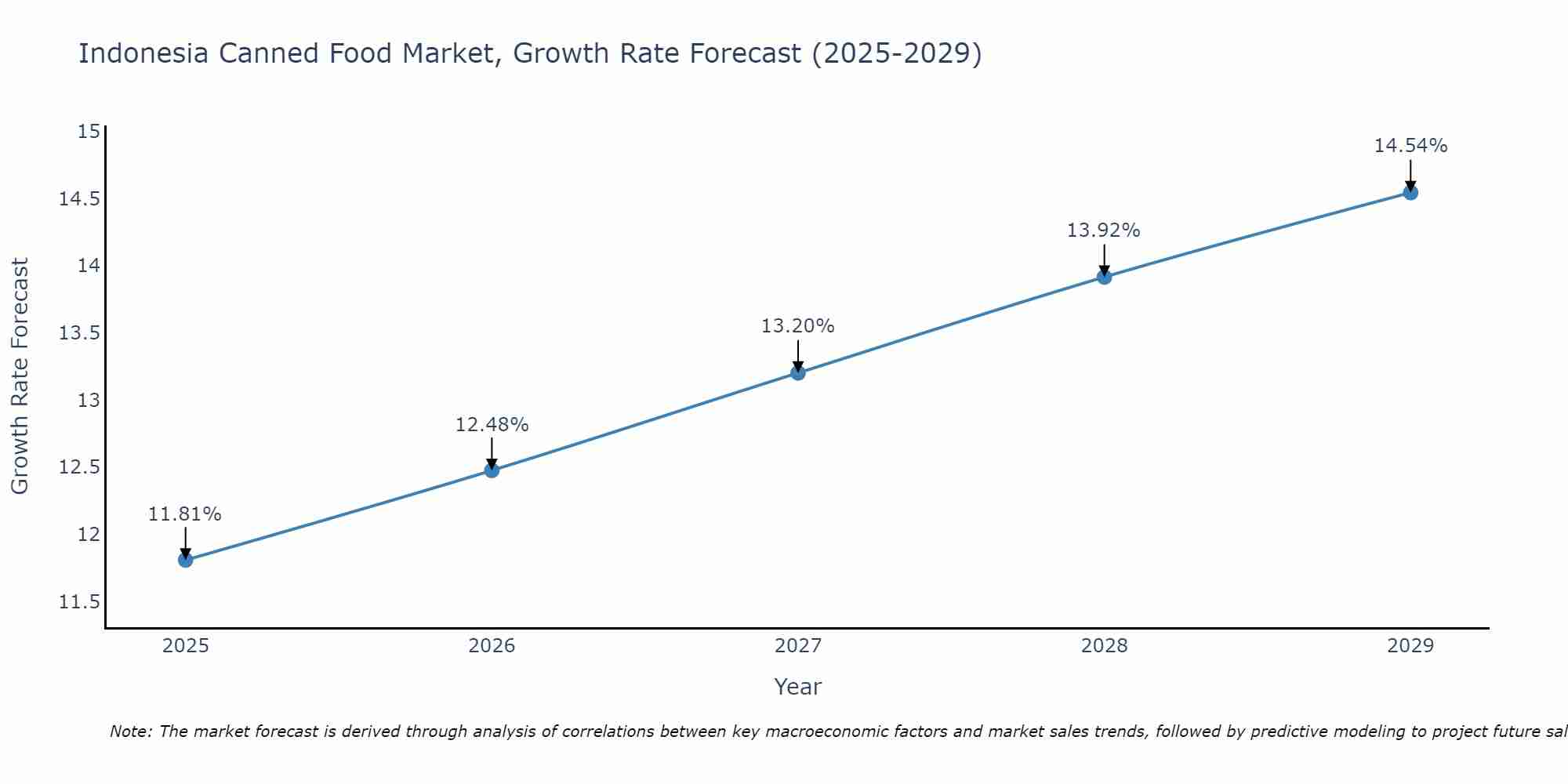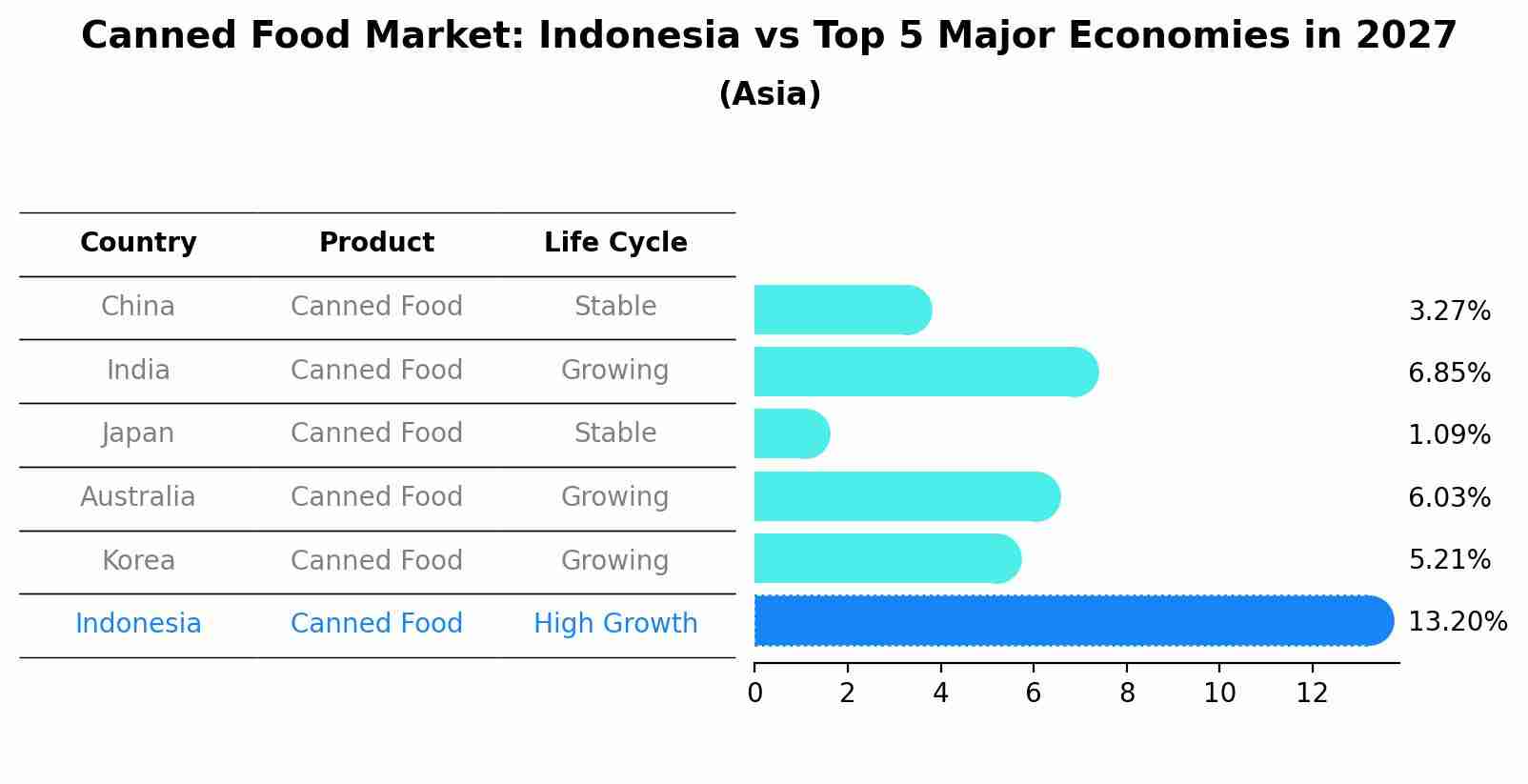Indonesia Canned Food Market (2025-2031) Outlook | Size, Value, Analysis, Industry, Revenue, Growth, Forecast, Share, Trends & Companies
| Product Code: ETC218008 | Publication Date: Aug 2023 | Updated Date: Aug 2025 | Product Type: Market Research Report | |
| Publisher: 6Wresearch | No. of Pages: 75 | No. of Figures: 35 | No. of Tables: 20 | |
Indonesia Canned Food Market Size Growth Rate
The Indonesia Canned Food Market is poised for steady growth rate improvements from 2025 to 2029. From 11.81% in 2025, the growth rate steadily ascends to 14.54% in 2029.

Canned Food Market: Indonesia vs Top 5 Major Economies in 2027 (Asia)
The Canned Food market in Indonesia is projected to grow at a high growth rate of 13.20% by 2027, highlighting the country's increasing focus on advanced technologies within the Asia region, where China holds the dominant position, followed closely by India, Japan, Australia and South Korea, shaping overall regional demand.

Indonesia Canned Food Market Synopsis
Canned food remains a significant segment of the Indonesian food market, offering consumers a range of preserved and ready-to-eat options. The market outlook for canned food in Indonesia remains positive, driven by its long shelf life and convenience.
Drivers of the Market
The canned food market in Indonesia is projected to witness steady growth due to its widespread consumption and extended shelf life. Canned food provides a convenient and long-lasting option for storing and consuming various food products, including vegetables, fruits, fish, and meat. The busy lifestyles of consumers and the need for easy-to-prepare meals contribute to the market`s positive outlook. Additionally, the growing demand for preserved and processed food products in both urban and rural areas further drives the canned food market.
Challenges of the Market
The canned food market in Indonesia faces challenges related to consumers` perception of canned products as less healthy compared to fresh alternatives. Manufacturers must emphasize the nutritional benefits, convenience, and long shelf life of canned food to change this perception. Another challenge is meeting consumers` preferences for natural and preservative-free products. Offering clean-label canned food options can help address this concern. Competing with other food preservation methods, such as frozen and dried foods, is another challenge in the canned food market. Differentiated product offerings and targeted marketing can help maintain a competitive edge.
COVID-19 Impact on the Market
The canned food market in Indonesia witnessed mixed trends during the pandemic. While there could have been increased sales of canned products due to their longer shelf life and pantry-stocking behavior, disruptions in manufacturing and distribution could have impacted the overall market.
Key Highlights of the Report:
- Indonesia Canned Food Market Outlook
- Market Size of Indonesia Canned Food Market, 2024
- Forecast of Indonesia Canned Food Market, 2031
- Historical Data and Forecast of Indonesia Canned Food Revenues & Volume for the Period 2021-2031
- Indonesia Canned Food Market Trend Evolution
- Indonesia Canned Food Market Drivers and Challenges
- Indonesia Canned Food Price Trends
- Indonesia Canned Food Porter's Five Forces
- Indonesia Canned Food Industry Life Cycle
- Historical Data and Forecast of Indonesia Canned Food Market Revenues & Volume By Product Type for the Period 2021-2031
- Historical Data and Forecast of Indonesia Canned Food Market Revenues & Volume By Canned meat & seafood for the Period 2021-2031
- Historical Data and Forecast of Indonesia Canned Food Market Revenues & Volume By Canned fruit & vegetables for the Period 2021-2031
- Historical Data and Forecast of Indonesia Canned Food Market Revenues & Volume By Canned ready meals for the Period 2021-2031
- Historical Data and Forecast of Indonesia Canned Food Market Revenues & Volume By Others for the Period 2021-2031
- Historical Data and Forecast of Indonesia Canned Food Market Revenues & Volume By Type for the Period 2021-2031
- Historical Data and Forecast of Indonesia Canned Food Market Revenues & Volume By Organic for the Period 2021-2031
- Historical Data and Forecast of Indonesia Canned Food Market Revenues & Volume By Conventional for the Period 2021-2031
- Historical Data and Forecast of Indonesia Canned Food Market Revenues & Volume By Distribution Channel for the Period 2021-2031
- Historical Data and Forecast of Indonesia Canned Food Market Revenues & Volume By Supermarket/Hypermarket for the Period 2021-2031
- Historical Data and Forecast of Indonesia Canned Food Market Revenues & Volume By Convenience stores for the Period 2021-2031
- Historical Data and Forecast of Indonesia Canned Food Market Revenues & Volume By E-commerce for the Period 2021-2031
- Historical Data and Forecast of Indonesia Canned Food Market Revenues & Volume By Others for the Period 2021-2031
- Indonesia Canned Food Import Export Trade Statistics
- Market Opportunity Assessment By Product Type
- Market Opportunity Assessment By Type
- Market Opportunity Assessment By Distribution Channel
- Indonesia Canned Food Top Companies Market Share
- Indonesia Canned Food Competitive Benchmarking By Technical and Operational Parameters
- Indonesia Canned Food Company Profiles
- Indonesia Canned Food Key Strategic Recommendations
Frequently Asked Questions About the Market Study (FAQs):
1 Executive Summary |
2 Introduction |
2.1 Key Highlights of the Report |
2.2 Report Description |
2.3 Market Scope & Segmentation |
2.4 Research Methodology |
2.5 Assumptions |
3 Indonesia Canned Food Market Overview |
3.1 Indonesia Country Macro Economic Indicators |
3.2 Indonesia Canned Food Market Revenues & Volume, 2021 & 2031F |
3.3 Indonesia Canned Food Market - Industry Life Cycle |
3.4 Indonesia Canned Food Market - Porter's Five Forces |
3.5 Indonesia Canned Food Market Revenues & Volume Share, By Product Type, 2021 & 2031F |
3.6 Indonesia Canned Food Market Revenues & Volume Share, By Type, 2021 & 2031F |
3.7 Indonesia Canned Food Market Revenues & Volume Share, By Distribution Channel, 2021 & 2031F |
4 Indonesia Canned Food Market Dynamics |
4.1 Impact Analysis |
4.2 Market Drivers |
4.2.1 Increasing demand for convenience foods due to busy lifestyles |
4.2.2 Growing urbanization leading to higher disposable incomes |
4.2.3 Rising awareness about food safety and hygiene |
4.3 Market Restraints |
4.3.1 Price volatility of raw materials impacting production costs |
4.3.2 Competition from fresh food alternatives |
4.3.3 Concerns about the nutritional content of canned foods |
5 Indonesia Canned Food Market Trends |
6 Indonesia Canned Food Market, By Types |
6.1 Indonesia Canned Food Market, By Product Type |
6.1.1 Overview and Analysis |
6.1.2 Indonesia Canned Food Market Revenues & Volume, By Product Type, 2021-2031F |
6.1.3 Indonesia Canned Food Market Revenues & Volume, By Canned meat & seafood, 2021-2031F |
6.1.4 Indonesia Canned Food Market Revenues & Volume, By Canned fruit & vegetables, 2021-2031F |
6.1.5 Indonesia Canned Food Market Revenues & Volume, By Canned ready meals, 2021-2031F |
6.1.6 Indonesia Canned Food Market Revenues & Volume, By Others, 2021-2031F |
6.2 Indonesia Canned Food Market, By Type |
6.2.1 Overview and Analysis |
6.2.2 Indonesia Canned Food Market Revenues & Volume, By Organic, 2021-2031F |
6.2.3 Indonesia Canned Food Market Revenues & Volume, By Conventional, 2021-2031F |
6.3 Indonesia Canned Food Market, By Distribution Channel |
6.3.1 Overview and Analysis |
6.3.2 Indonesia Canned Food Market Revenues & Volume, By Supermarket/Hypermarket, 2021-2031F |
6.3.3 Indonesia Canned Food Market Revenues & Volume, By Convenience stores, 2021-2031F |
6.3.4 Indonesia Canned Food Market Revenues & Volume, By E-commerce, 2021-2031F |
6.3.5 Indonesia Canned Food Market Revenues & Volume, By Others, 2021-2031F |
7 Indonesia Canned Food Market Import-Export Trade Statistics |
7.1 Indonesia Canned Food Market Export to Major Countries |
7.2 Indonesia Canned Food Market Imports from Major Countries |
8 Indonesia Canned Food Market Key Performance Indicators |
8.1 Consumer satisfaction ratings for canned food products |
8.2 Frequency of new product launches in the canned food market |
8.3 Adoption rate of innovative packaging technologies in the canned food sector |
9 Indonesia Canned Food Market - Opportunity Assessment |
9.1 Indonesia Canned Food Market Opportunity Assessment, By Product Type, 2021 & 2031F |
9.2 Indonesia Canned Food Market Opportunity Assessment, By Type, 2021 & 2031F |
9.3 Indonesia Canned Food Market Opportunity Assessment, By Distribution Channel, 2021 & 2031F |
10 Indonesia Canned Food Market - Competitive Landscape |
10.1 Indonesia Canned Food Market Revenue Share, By Companies, 2024 |
10.2 Indonesia Canned Food Market Competitive Benchmarking, By Operating and Technical Parameters |
11 Company Profiles |
12 Recommendations |
13 Disclaimer |
- Single User License$ 1,995
- Department License$ 2,400
- Site License$ 3,120
- Global License$ 3,795
Search
Related Reports
- ASEAN Bearings Market (2025-2031) | Strategy, Consumer Insights, Analysis, Investment Trends, Opportunities, Growth, Size, Share, Industry, Revenue, Segments, Value, Segmentation, Supply, Forecast, Restraints, Outlook, Competition, Drivers, Trends, Demand, Pricing Analysis, Competitive, Strategic Insights, Companies, Challenges
- Europe Flooring Market (2025-2031) | Outlook, Share, Industry, Trends, Forecast, Companies, Revenue, Size, Analysis, Growth & Value
- Saudi Arabia Manlift Market (2025-2031) | Outlook, Size, Growth, Trends, Companies, Industry, Revenue, Value, Share, Forecast & Analysis
- Uganda Excavator, Crane, and Wheel Loaders Market (2025-2031) | Strategy, Consumer Insights, Analysis, Investment Trends, Opportunities, Growth, Size, Share, Industry, Revenue, Segments, Value, Segmentation, Supply, Forecast, Restraints, Outlook, Competition, Drivers, Trends, Demand, Pricing Analysis, Competitive, Strategic Insights, Companies, Challenges
- Rwanda Excavator, Crane, and Wheel Loaders Market (2025-2031) | Strategy, Consumer Insights, Analysis, Investment Trends, Opportunities, Growth, Size, Share, Industry, Revenue, Segments, Value, Segmentation, Supply, Forecast, Restraints, Outlook, Competition, Drivers, Trends, Demand, Pricing Analysis, Competitive, Strategic Insights, Companies, Challenges
- Kenya Excavator, Crane, and Wheel Loaders Market (2025-2031) | Strategy, Consumer Insights, Analysis, Investment Trends, Opportunities, Growth, Size, Share, Industry, Revenue, Segments, Value, Segmentation, Supply, Forecast, Restraints, Outlook, Competition, Drivers, Trends, Demand, Pricing Analysis, Competitive, Strategic Insights, Companies, Challenges
- Angola Excavator, Crane, and Wheel Loaders Market (2025-2031) | Strategy, Consumer Insights, Analysis, Investment Trends, Opportunities, Growth, Size, Share, Industry, Revenue, Segments, Value, Segmentation, Supply, Forecast, Restraints, Outlook, Competition, Drivers, Trends, Demand, Pricing Analysis, Competitive, Strategic Insights, Companies, Challenges
- Israel Intelligent Transport System Market (2025-2031) | Strategy, Consumer Insights, Analysis, Investment Trends, Opportunities, Growth, Size, Share, Industry, Revenue, Segments, Value, Segmentation, Supply, Forecast, Restraints, Outlook, Competition, Drivers, Trends, Demand, Pricing Analysis, Competitive, Strategic Insights, Companies, Challenges
- Uganda Precast and Aggregate Market (2025-2031) | Strategy, Consumer Insights, Analysis, Investment Trends, Opportunities, Growth, Size, Share, Industry, Revenue, Segments, Value, Segmentation, Supply, Forecast, Restraints, Outlook, Competition, Drivers, Trends, Demand, Pricing Analysis, Competitive, Strategic Insights, Companies, Challenges
- Australia IT Asset Disposal Market (2025-2031) | Strategy, Consumer Insights, Analysis, Investment Trends, Opportunities, Growth, Size, Share, Industry, Revenue, Segments, Value, Segmentation, Supply, Forecast, Restraints, Outlook, Competition, Drivers, Trends, Demand, Pricing Analysis, Competitive, Strategic Insights, Companies, Challenges
Industry Events and Analyst Meet
Our Clients
Whitepaper
- Middle East & Africa Commercial Security Market Click here to view more.
- Middle East & Africa Fire Safety Systems & Equipment Market Click here to view more.
- GCC Drone Market Click here to view more.
- Middle East Lighting Fixture Market Click here to view more.
- GCC Physical & Perimeter Security Market Click here to view more.
6WResearch In News
- Doha a strategic location for EV manufacturing hub: IPA Qatar
- Demand for luxury TVs surging in the GCC, says Samsung
- Empowering Growth: The Thriving Journey of Bangladesh’s Cable Industry
- Demand for luxury TVs surging in the GCC, says Samsung
- Video call with a traditional healer? Once unthinkable, it’s now common in South Africa
- Intelligent Buildings To Smooth GCC’s Path To Net Zero













